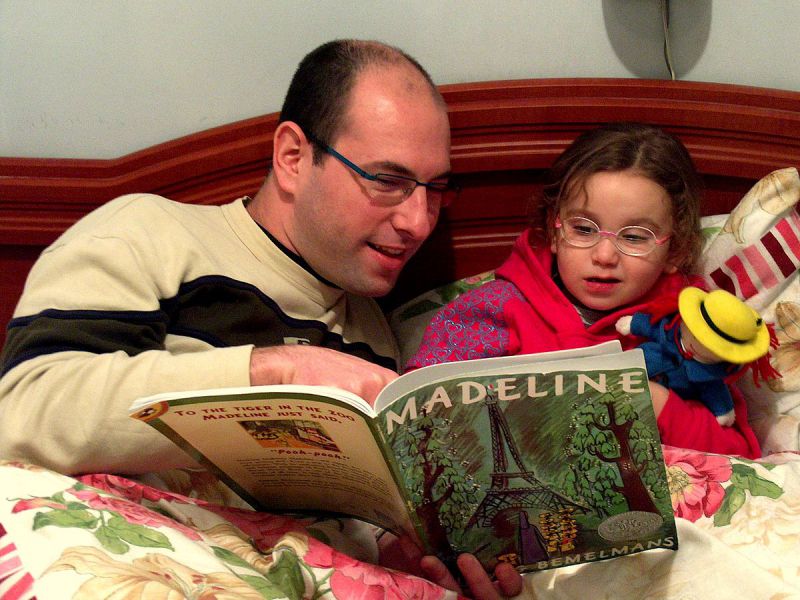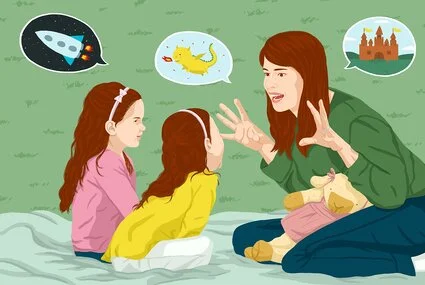One of the fondest memories of childhood is the bedtime stories that our parents, grandparents, and guardians used to narrate. Usually, bedtime stories are what little kids look up to the most. It is the intrigue of tales and a new story that always keeps children on their toes.
However, with the surge in media and hectic schedules, parents would often trade in story-time sessions with the newest video which has hit streaming platforms. We do not say that it is a cardinal sin to do so. But, bedtime stories have great relevance for the best parent-child rapport. Stories keep away the monotony of our bustling lives. It also acts as a personal haven for families to bond.
Bedtime routine is very essential for every child’s growth. It nurtures the bond between parents and children. Therefore, we bring you the foremost benefits of bedtime stories and narrating them to your children. Who knows your story sessions might spur a good story for your grandkids and the generations following them? Let’s preserve this art of storytelling and read further!
Why Should You Read Bedtime Stories to Kids?
Cognitive Skills
Reading bedtime stories from a very early age prompts children to retain information for a prolonged period. Babies around 10 months can learn to turn pages and listen to new words. Thanks to a regular routine with bedtime stories. Such nighttime routine encourages early language development and vocabulary in children. Therefore, don’t be shy to pick a book! If you’re not sure, try our recommendations from these lists.
Improved Attention
Engaging children in listening to bedtime stories every night is an excellent way to get them comfortable with reading habits. Bedtime stories come with improved concentration- observe your child when they are listening to a story. Not only do they hold onto the storyline but are deeply invested in the characters’ motivations and actions.

Reducing Stress
After a long day of playing around and the pressure of studies, children need to wind up their thoughts before ending their day. Bedtime routine where you spend time together while reading stories helps them relax and reduce their stress levels, helping them sleep better.

A Healthy Habit
When you read stories to children every night, it becomes a habit and a part of their lives. Gradually, children pick up night-time reading as a life-long habit if they are listening to the stories from an early phase. Their love for bedtime stories continues well into their teenage years where they can enjoy reading before bedtime by themselves.

Bedtime Stories is Me Time
Read bedtime stories to children without the distractions of technology or any other work. Kids value their one on one time with parents, they know that it’s their time and they can talk about various things.

Books add to the calmness of the surroundings. Even if you are going through a rough patch in your relationship, this is a perfect opportunity to bond with them. You can interact and engage in conversations that you may not have otherwise.
Anchor to Feelings
Cuddling together with your parents, grandparents, or siblings to talk about a story before drifting off to sleep is an idyllic image that should be every child’s reality.
You get and give lots of cuddles while reading bedtime stories which is good for your relationship together.
Outlet for Empathy
Kids tend to develop moral values like empathy as well as critical thinking as they navigate through these bedtime stories. These stories matter as they give children an outlet to think about their own actions via a character doing the same. Not only does it help them evaluate the rights and wrongs of action but they also tend to develop a better scope for empathizing and understanding the motivations of people around them.

Fosters Interpretation
When parents read stories to kids, they get better at imagining things as they imagine the plot and the scenes in their minds and try to live it. Their little brain receives so many ideas, they are able to predict what will happen next and sometimes come up with their own endings. As you read to your children, make them look and answer questions to promote thinking skills and social development.

It helps them become independent readers and later tend to start reading books that don’t have many pictures because their imagination is developed enough to draw them.
Language Skills
Books introduce a greater variety of words than just everyday vocabulary. Children learn more sophisticated words and improve language skills if they read from different genres of books. Children often remember stories and also the words used frequently by the important characters of the story. The more you read, the more children are exposed to words. Let them imitate sounds, recognize pictures, know the meaning of new words, and learn them.
By exaggerating the “oo” sound in the moon and using words like hush and buzz, you can stimulate connections in the part of their brain that handles language sounds. This part of the brain is also referred to as the auditory cortex.
Children find a lot of new words to think, feel and express their feelings.
Don’t worry about reading the same story, again and again, small children love and learn from repetition.
Curiosity
Reading promotes more reading as they become inquisitive and want to find other books that can kindle their imaginations.

Children also ask and answer questions when you read stories to them, so it stimulates new conversations.
Parents can relate the stories to the real world and help them imbibe the learning from the stories into their life swiftly. Sometimes, scary things or complicated situations might worry them, but they can understand it in safe ways when they learn through characters and while holding your hands.
Decoding the Circle of Life
In today’s world, where children have so much to learn and keep pace with new technology, they have lost touch with their cultural heritage. Bedtime stories are a good way to introduce our kids to our legends, folk culture, and mythology. These tales can give children an inherent understanding of human nature and the philosophy of life. Stories with well-defined morals have proved to increase moral values in children.

Now It’s Time to learn How to make these story time More Interesting
For both children and parents, few moments are more memorable and unique than bedtime stories when you and your little one cuddle at night, snoozing to the story unfold.
Reading provides a variety of advantages. It can help enhance your child’s comprehension of words, help more than any other vocabulary-building exercise and assist in addressing and making clear what happens throughout the world.
In this article we will take a deeper look at some strategies and tips you can employ to improve the experience of reading at bedtime, suitable for youngsters of all ages for preschoolers, toddlers, or even for older children.
9 ways to make bedtime stories more enjoyable and interesting
Let’s get into the reason you’re here – our top nine tips that can be used to make bedtime stories enjoyable and exciting for your kid.
1. It’s never too late to begin reading to your kids prior to the bedtime
Reading to your baby at any time – in fact, the earlier you begin reading to them the more effective it becomes. There’s another school of thought that reading to children when they are in the womb can be beneficial both for educational purposes and to foster a stronger bond.
The earlier you begin reading to your child and the faster they’ll begin learning new words, whether it’s numbers, shapes, as well as the name of color or dinosaurs. Building their vocabulary earlier will give them an important advantage when it is time to move to higher grades.
It’s not just about the educational benefits, kids also enjoy reading stories, and it’s one of the best ways to connect and bond with your children. Also, it won’t last very long, as children grow rapidly, so be sure you enjoy this time with your child, and even before you realize it, they’ll be grumpy teenagers with their smartphones glued to them and locked in their rooms.
2. The bedtime stories don’t have to be read at night. A comfy reading corner is equally as great and, in some cases, even more so
A lot of parents see stories as something that takes place exclusively in the evening and is an essential part of any bedtime routine. Why should you be restricted? Any time is a good time to read with your child which means it doesn’t need to take place in bed; it’s possible to read with your kid anytime.
If you’re not sure what the reading nook is – it is an unintentional space that is set up to read. It is usually located in the corner of a room that has access to light. It’s fairly simple to set it up if you have the space and it can turn reading time into a wonderful escape.

There’s no need to think about it. Perhaps put up a dinosaur play tent, add some comfy dinosaur blankets, or a child’s sleeper bag with a dinosaur, and the dinosaur lamp or nightlight for reading at night You’re set. There’s no set of rules in this case – as long as you have the right lighting and comfort you can create whatever you’d like to do with your corner and have fun with your decor!
3. Have a diverse and wide collection of books for your children
It is a fact that – yet we’ll say it that the only easiest way to make the storytime experience enjoyable is to keep sufficient books to read at home. Allow people to play with their selection of books every night to make it as exciting as you can.
It’s not a good idea to keep reading the same tired, old tales. Since this becomes an easy way to take all the enjoyment out of bedtime tales making it something boring and uninteresting that your child will be disengaged from.

While you’re unlikely to be able to store an entire library of books in the space between bookshelf dinosaurs but with a good amount of planning and organization you can have an adequate selection of books at home, which will provide your child with plenty of options to pick from.
4. Let your child pick the books that you read to them
Although variety is important you should also involve your child in selecting a book each night during storytime. This is an easy one since they’re likely to be more engaged and interested in listening to the stories from the book they’ve chosen.
Based on the storage options you have it might not be feasible to pick out a book physically. Perhaps you store yours in a bookcase or shelf which isn’t accessible, or, a lot of parents do they don’t want to tackle the mess that occurs when they go through the pile of books. Removing them and throwing them around all over the place while they move.
The most effective option is to select some of them yourself, say three or four options, and then present them to your child for them to decide. This will prevent any confusion or difficulties in accessing your library and help you choose the right book much easier.
5. If you’re not giving an absurd voice to every person, then you’re doing it wrong
Nothing can cause more harm to a story at bedtime than a boring, flat-voiced delivery. This is why it’s crucial to provide your characters with funny and jolly voices and add fun sound effects when you are reading.
It is also important to adjust the pitch of your voice, raising and lowering the pitch, to better differentiate between characters. This makes it easier for your child to understand the story.
By doing these things, you can make your story a much more enjoyable experience and keep your child captivated by each word that you read to them. Don’t be afraid to make yourself look embarrassed. You’re not in public – you’re in your home, spending the time you have with your child. Simply put, read to your child without overthinking about your expressive narration style.
6. Try to establish the scene prior to jumping into the story.
The most significant distinction between the best storytellers and the average ones can be their capacity to establish the stage correctly, creating an atmosphere that draws you in while they tell stories.
Before you begin reading the words out of the page, discuss what could occur in the story. You can also create an explanation for those characters. Or, even a collection of other fictional incidents that will allow your child to be more connected to the characters and, ultimately the story.
You can also make them more real, making use of everyday references to give the story more credibility. Be careful not to overdo it. It’s best to keep the story simple. Perhaps Little Red Riding Hood wasn’t only visiting her grandmother, maybe she was picking up her groceries at Walmart. Perhaps Rapunzel’s hair was not long due to her being in a tower. Maybe she was unable to get out to her hair salon since it was closed during the outbreak. This may sound ridiculous initially however, it’s actually an extremely useful instrument for explaining current happenings in an easy manner that can be understood by the kids.
7. Do not read to them. Read with them
The greatest aspect of reading to your child and the reason even with all the availability of other media devices and content that we use nowadays, it’s still loved – is that as a media it is both a bedtime story and a nighttime tale.
It’s crucial not to read them but rather read alongside them, engaging and communicating with them throughout the process, not simply reading words on the page.
Make sure to incorporate plenty of pauses while reading to your child, and give them the opportunity to ask questions or even make comments or thoughts about your story’s progress. They are essential in helping them gain an understanding of the words and different social themes and the interactions they involve.
8. Your stories can be brought to life with props that make your stories more exciting
Let’s face it even if you’re considered to be the most entertaining storyteller in the world the stories get old after a while. This is why it is crucial to do everything it takes to ensure that you keep your child interested. There are limited books that you can fit between your bookends of dinos. Props are also a great way to keep these stories fresh by taking classics in fresh and thrilling directions.
One method to accomplish this is to incorporate certain props in the mixture, items like dinosaur hand puppets or the dinosaur’s finger puppets are awesome – however, you don’t need to buy anything. The ones which are already in their dinosaur toy box could be a fantastic prop.

There are dinosaur plush toys such as figures, or the vast majority of dino toys make excellent props that make your stories come to life. They can also aid in introducing your child to acting and role-playing taking on different characters from the story and reenacting their own version of things by using the props they have in their hands to go wherever they would like to take it.
9. There’s no need to sit around until it’s bedtime. You can read to your kids anywhere, any time.
Parents often make the mistake of restricting their story-telling to at night by limiting this important practice to a specific time every day. However, whether it’s at breakfast, or before taking an afternoon nap, or simply enjoying a lazy day at the local park, no matter what the time of day or where you are it’s always a great time to tell a good story.
Although you might not realize it initially, taking a few minutes from your schedule to spend time reading to your child will make an enormous difference. It will have a compounding effect over time which will give them an advantage over the other kids in their ability to communicate once they start going to school.
You don’t need to carry around a bag of books wherever you go, except in the event of an unexpected story – you can download children’s stories right on your smartphone or tablet. There’s no reason to not pick an engaging story to read to your kid at any time the opportunity is presented.
FAQ
What is a good bedtime story?
Bedtime stories for babies Below 1 to 12 months
1. My Mum / My Dad by Anthony Browne.
2. Hush Little Baby by Sylvia Long.
3. Goodnight, Gorilla by.
4. I’m Not Sleepy.
5. Say Goodnight to the Sleepy Animals.
6. Goodnight Moon by Margaret Wise Brown.
7. A Recipe for Bedtime by Peter Bently.
8. Dr. Seuss’s Sleep Book by Dr. Seuss.
What are classic bedtime stories?
1. The Bremen Town Musicians.
2. The Three Billy Goats Gruff.
3. The Lion and the Mouse.
4. Jack and the Beanstalk.
5. The Country Mouse and the City Mouse.
6. Sleeping Beauty.
7. The Tortoise and the Hare.
8. Little Sambha and the Tigers.
Why do children love bedtime stories?
Bedtime stories are a form of storytelling that is traditionally a practice of reading stories to children at night to help them sleep. Bedtime stories can provide many advantages for parents and children alike.
Parents should be reading to their children?
Reading aloud books to youngsters encourages their imaginations and broadens their knowledge of the world around them. It assists them in the development of listening and language skills and helps them comprehend writing. Even after your child is able to read on their own it’s vital to read aloud with them.
Why parents should read to their children?
This is extremely beneficial for the children’s progress in school because it improves their focus, memory, listening, and imagination in an enjoyable and imaginative manner. When you read bedtime tales to your children, it can make them much more inclined to sit down and read themselves. It can also spark an interest in books that lasts for a lifetime.
What is the average bedtime for a 13-year-old?
For teens, Studies suggest that teenagers aged 13 to 16 should be asleep by 11:30 pm. But our school system has to undergo a complete overhaul in order to accommodate teens’ biological clocks. If they’re between 13-15years, they’re supposed to be at school by 10 am and need to get up by 8 am.
Final Thoughts
A love for reading is one of the best gifts parents can give to their children. The benefits of reading bedtime stories influence their personalities and your relationship for years. If you are struggling to connect with your child, these stories and the time with them gives you something in common to talk about and break the ice.
Imagination is more important than knowledge. Knowledge is limited. Imagination encircles the world. Albert Einstein
Most importantly, interaction with your children is the key to making the most out of the bedtime story reading. Therefore, Podium swears by the magic of storytelling for parents and children alike.
While you’re engrossed with bedtime stories, we invite you to substitute regular fables and fairy tales with these books by A.A. Milne and Beatrix Potter! You may also check out our best classic recommendations for young darlings to soothe them into a deep and dreamy sleep.
Share with your friends






